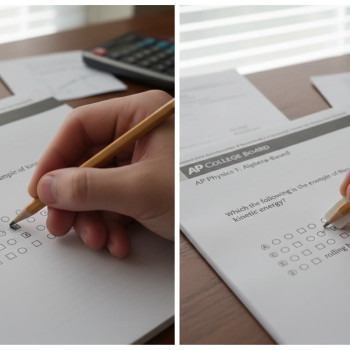Why This Plan Works (and Why You Still Have Time)
Falling behind in an AP course can feel like standing at the base of a mountain and realizing the summit is only 30 days away. Breathe. You’re not alone, and you can climb this. The truth is that AP exams reward targeted understanding and smart practice more than sheer time spent. This 30-day recovery plan focuses on priorities: concept triage, practice that mimics the exam, and a sustainable rhythm that prevents burnout.
Who this plan is for
- Students with roughly one month until their AP exam who feel behind on content.
- Students who still attend class but need a focused revision strategy.
- Students preparing independently or supplementing class work—ideal for anyone who wants a short, high-impact catch-up schedule.

Big-Picture Strategy: The Four Pillars
Before you dive into daily tasks, adopt these four pillars. Think of them as the compass of your 30-day journey.
1. Prioritize High-Impact Topics
AP exams weight certain units and skills more heavily. Identify which topics historically appear most often and which you personally struggle with. Spend more time on those—less time on low-yield details.
2. Active, Exam-Like Practice
Passive reading helps once you already understand a concept. If you’re behind, switch to active methods: timed multiple-choice sections, free-response practice, and self-explaining problems out loud. Use official practice questions when possible.
3. Spaced Review and Spiral Reinforcement
Build short, frequent review loops into your schedule so that earlier topics aren’t forgotten. A 10–20 minute “spiral review” each day keeps old material fresh while you learn new stuff.
4. Health and Energy Management
Quality of study beats quantity. Prioritize sleep, hydration, brief movement breaks, and consistent mealtimes. You’ll retain far more when your brain is rested.
Week-by-Week Breakdown: What to Do Each Day
The plan below assumes you have 30 days. Each week has a theme and daily tasks that balance learning, practice, and review. Adjust the exact hours to fit your school day and commitments—consistency is the goal.
Week 1 — Triage and Foundation (Days 1–7)
Goal: Map the landscape of what you don’t know and shore up foundational concepts.
- Day 1 — Assessment Day: Take a timed, mixed-practice exam (or practice section) to identify weak areas. Note which question types and topics cause trouble.
- Days 2–3 — Core Concepts: Study the top 3–5 high-weight topics you missed. Use unit outlines and AP Classroom resources to focus on skills and exam format.
- Day 4 — Guided Practice: Do targeted practice questions on those topics under timed conditions.
- Day 5 — Spiral Review: 20 minutes revising Day 2–3 material; 40 minutes practicing new question sets.
- Day 6 — Synthesis: Connect concepts. For example, if you study AP Biology, link cellular processes to physiological systems; if AP US History, link causes to consequences across time.
- Day 7 — Checkpoint Test: Light full-length section or a set of mixed practice questions with timing to measure progress.
Week 2 — Build and Practice (Days 8–14)
Goal: Broaden coverage, build fluency with question types, and practice pacing.
- Days 8–10 — Topic Blocks: Each day, pick two medium-weight topics. 60 minutes concept review + 45 minutes of practice questions + 15 minutes spiral review.
- Day 11 — Free-Response Focus: Practice 1–2 full free-response questions. Spend time writing and then scoring against official rubrics.
- Day 12 — Timed Multiple-Choice Session: Simulate a section of the exam under strict time.
- Day 13 — Weak-Point Day: Return to the mistakes from Days 8–12 and create error-correction notes.
- Day 14 — Checkpoint: Full practice section or a shortened practice exam to evaluate speed and accuracy.
Week 3 — Intensive Simulation (Days 15–21)
Goal: Increase exam-like stamina and refine exam strategies.
- Day 15 — Full-Length Practice Test (if time permits). Otherwise, full multiple-choice and timed FRQ segments.
- Days 16–17 — Review Test Results: Spend a session correcting the practice test. Analyze the reasoning behind each mistake—this is where the most learning happens.
- Day 18 — Targeted Drill: Drill the most common question patterns that still trip you up.
- Day 19 — Answer Structuring: Practice writing concise, rubric-focused responses for free-response questions.
- Day 20 — Speed and Strategy: Practice quick elimination techniques for MCQs and time checkpoints for FRQs.
- Day 21 — Recovery & Reflection: Light review, rest, and plan adjustments for the final week.
Week 4 — Polish and Confidence (Days 22–30)
Goal: Consolidate knowledge, minimize careless errors, and finalize test-day logistics.
- Days 22–24 — Mixed Practice with Feedback: Short, timed blocks mixing MCQs and FRQs, followed by immediate correction.
- Day 25 — Mini Full Test: Simulate one exam section with strict timing and environment control.
- Days 26–27 — Final Content Blitz: Quick refresh of any lingering tricky topics and review of high-yield facts or formulas.
- Day 28 — Exam Strategy Run-Through: Practice time management, skipping and returning strategies, and writing a quick introduction for FRQs.
- Day 29 — Logistics and Light Review: Prepare materials, check testing app or paper logistics, and sleep early.
- Day 30 — Calm Day: Light review only. Trust your prep. Hydrate, rest, and pace yourself.
Daily Routine Template (2–4 Hours a Day)
You don’t need to study all day. Here’s a focused template you can adapt.
- Warm-Up (15–20 min): Quick spiral review—flashcards, formulas, or quick practice questions from previous days.
- Deep Work Block (50–90 min): Focus on one high-impact topic. Use active learning—practice problems, explain concepts aloud, or draw diagrams.
- Break (10–20 min): Move, hydrate, eat—a true break helps consolidate learning.
- Practice Block (40–60 min): Timed question sets that mimic the exam format you’re working on.
- Reflection & Error Correction (15–25 min): Correct mistakes immediately, write a short note on why you were wrong, and what to do next time.
Sample 30-Day Schedule Table
| Day | Focus | Primary Tasks | Time Estimate |
|---|---|---|---|
| 1 | Assessment | Take diagnostic section; list weakest 5 topics | 2–3 hrs |
| 2–4 | Top Weak Topics | Concept review + targeted practice | 2–3 hrs/day |
| 5–7 | Integration | Mixed practice + spiral review | 2–3 hrs/day |
| 8–14 | Mid-Range Topics | Topic blocks, FRQ practice, timed MCQ | 2–4 hrs/day |
| 15 | Simulation | Full-length practice or exam section | 3–4 hrs |
| 16–21 | Review & Drill | Review simulation, targeted drills | 2–3 hrs/day |
| 22–28 | Polish | Mixed practice, time strategies, final concept blitz | 2–3 hrs/day |
| 29–30 | Final Prep | Logistics check, light review, rest | 1–2 hrs/day |
Practical Tips, Pitfalls, and Low-Effort Wins
Test-Day Habits That Matter
- Do a quick 5–10 minute warm-up with easy practice questions to get your brain in exam mode.
- When stuck, mark the question and move on. Return if time allows—don’t let one item consume precious minutes.
- For FRQs, write a quick outline first. Clear structure often wins you points over perfect prose.
Common Pitfalls
- Relying only on passive review (re-reading notes) instead of practice.
- Studying for too long without breaks—fatigue hides errors.
- Trying to cram every little detail the night before; focus on high-yield material instead.
Low-Effort, High-Impact Tricks
- Create a one-page “cheat sheet” (for study only) summarizing formulas, timelines, and command terms. Reviewing this daily is powerful.
- Record yourself explaining a concept and listen back during a walk or commute—teaching strengthens recall.
- Use official rubric language when answering FRQs—look for scoring keywords and show your reasoning clearly.
How to Use Resources Effectively
Your AP teacher, AP Classroom, and official practice materials are gold. But if you need extra support, targeted 1-on-1 guidance can speed progress dramatically. Personalized tutoring—like Sparkl’s tutoring—can offer tailored study plans, expert tutors who focus on your exact weak points, and AI-driven insights that pinpoint error patterns. Integrating a few sessions into the early part of this 30-day plan (Weeks 1–2) can make your drills exponentially more effective.
Using Practice Questions Well
- Simulate testing conditions when you can: timed, quiet, and with minimal interruptions.
- After each set, spend more time reviewing solutions than taking the next set—error analysis is the multiplier for improvement.
- Track recurring mistake types (conceptual errors, careless mistakes, time management) and target them specifically.
Motivation and Mindset: Small Wins Add Up
When you’re behind, progress can feel slow. Counter that by measuring small wins. Celebrate a faster pace through a topic, a cleaner FRQ outline, or a day with fewer careless errors. Keep a short daily log: what you did, what improved, and what you’ll fix tomorrow. Over 30 days, these micro-improvements compound into real exam readiness.
When to Ask for Help
If after two weeks you don’t see steady improvement on checkpoint tests, escalate. Ask your teacher for targeted feedback on FRQs, or schedule focused 1-on-1 tutoring that zeroes in on persistent gaps. Sparkl’s personalized tutors are designed to slot into plans like this—providing tailored study plans, expert feedback, and sometimes AI-driven insights to reveal blind spots you didn’t know you had.
Last-Minute Checklist (48–24 Hours Before)
- Confirm testing logistics: location, format (digital vs. paper), and required materials.
- Pack what you need the night before: approved calculator (with fresh batteries if required), photo ID, pencils, erasers, water, and snacks for after the test.
- Review your one-page cheat sheet for 30–60 minutes—no new topics.
- Sleep—aim for 8 hours. Rest is the final ingredient in strong performance.
Real-World Example: How Two Students Recovered
Case A: Jenna missed several weeks due to illness and had two AP subjects on her plate. She used a 30-day plan that prioritized the single highest-weight unit in each class, scheduled three 1-on-1 tutoring sessions in Week 1 for diagnosis, and practiced official FRQs twice a week. Outcome: steady score improvement and calmer test days because she felt prepared for the core question types.
Case B: Marcus fell behind in AP Statistics because he avoided practice tests. He switched to daily timed drills, used a spiral review each morning, and logged errors in a dedicated notebook. He replaced one passive hour of review with mixed-practice blocks. Outcome: his pacing improved and he stopped making repeat conceptual mistakes.
Final Notes: You’re More Prepared Than You Think
Thirty days is short, but not impossible. The keys are ruthless prioritization, exam-like practice, immediate error correction, and sustainable habits. Make the first days diagnostic and the middle weeks practice-heavy. Use the last week to polish speed, clarity, and test logistics. If you need help, targeted tutoring—like Sparkl’s personalized sessions that offer 1-on-1 guidance and tailored study plans—can fit seamlessly into this schedule and accelerate progress.
Your 3-Point Action Right Now
- Take a quick diagnostic today (60–120 minutes) to identify the top 5 weaknesses.
- Write a simple 30-day calendar with Week 1 focused on those top weaknesses.
- Schedule one focused tutoring or teacher feedback session in Week 1 to ensure you’re fixing root causes, not symptoms.
You’ve got this. One day, one topic, one practice set at a time—30 focused days can regain lost ground and turn panic into performance. When you feel overwhelmed, come back to this plan, trim it to your priorities, and keep moving forward.

Quick Reference: Resource Checklist
- Official practice questions and rubrics for your AP subject.
- AP Classroom videos and unit guides for concise topic refreshers.
- Timed practice tests (full or sectional) to build stamina.
- Tiny daily tools: a one-page cheat sheet, error-log notebook, and a simple calendar for the 30 days.
Parting Thought
Recovery isn’t about perfection—it’s about direction. Follow this plan with honesty: track what works, drop what doesn’t, and ask for help where progress stalls. With focus, the right practice, and support when needed, you can close the gap and walk into your AP exam ready to show what you know.




















No Comments
Leave a comment Cancel